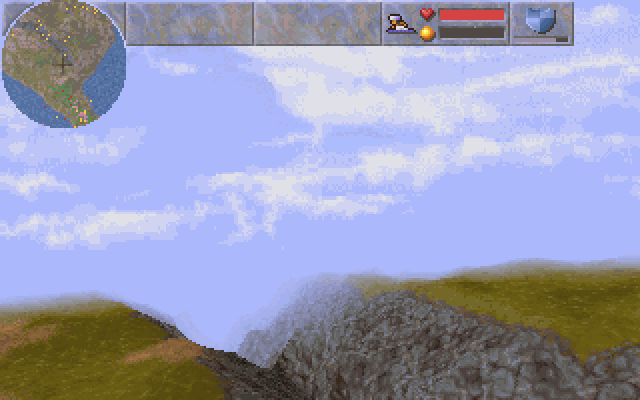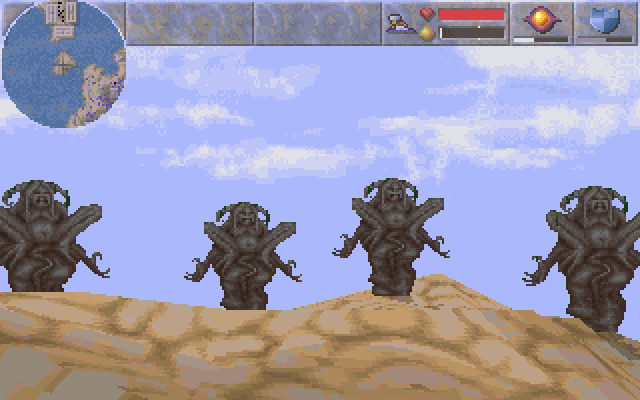Retro Replay Review
Gameplay
Magic Carpet places you squarely in the robes of a fledgling mage, hurtling over vibrant seas and jagged islands on your trusty flying carpet. The first-person perspective is immersive: you lean into your maneuvers, banking around spires and diving toward golden mana spheres scattered across the terrain. A core loop of exploration and resource management drives each of the 50 worlds, challenging you to balance aerial acrobatics with tactical castle-building.
(HEY YOU!! We hope you enjoy! We try not to run ads. So basically, this is a very expensive hobby running this site. Please consider joining us for updates, forums, and more. Network w/ us to make some cash or friends while retro gaming, and you can win some free retro games for posting. Okay, carry on 👍)
The central mechanic revolves around collecting mana and funneling it into your ever-growing castle. By casting the castle spell, you raise battlements from the earth, then strengthen your fortress by re-casting the same incantation. As your citadel swells, so does its capacity to store mana, which is ferried skyward by a floating balloon. This tower-upgrading system feels remarkably rewarding; each enlargement brings a tangible sense of progression and opens up space for more mana harvesting.
Combat is another pillar of the experience. Rival wizards and monstrous creatures roam each level, hurling fireballs or summoning golems to thwart your efforts. You’re armed with an arsenal of spells—fire, lightning, meteors, and more exotic incantations like skeleton armies or terrain-altering volcanoes. Dropping an enemy often yields bonus mana, making offensive spells as essential as your castle foundation.
Strategic depth emerges as new spells unlock over time. Early levels limit you to basic projectiles, but by midgame you’ll be teleporting across the map, erecting protective shields, and carving rivers through mountain chains. Juggling offense, defense, and infrastructure feels like conducting a magical orchestra; you’re never short on options, but you must choose the right combination for each island’s layout and the peculiar threats that inhabit it.
Finally, the seamless 3D flight allows full freedom of movement—altitude, pitch, and roll all matter. You can hover for precision castle-building, dive-bomb an enemy stronghold, or swoop up to catch stray mana spheres drifting near the water’s surface. A pop-up top-down map helps you plan your route, though mastering your carpet controls is half the fun.
Graphics
For its time, Magic Carpet’s visuals were nothing short of revolutionary. The polygonal landscapes of sea and stone shift dynamically as you carve through mountains or rise above cloudbanks. Water ripples beneath you, reflecting light in real time, and each island cluster feels distinct thanks to varying color palettes and cliff formations. The sense of scale is impressive, especially when you hover hundreds of feet above the waves.
Spell effects shine—literally. Fireballs blaze against dark rock, lightning bolts crackle with electric blue streaks, and meteor showers light up the night sky. Dynamic lighting accents give your castle spells an almost living glow as battlements grow larger and lanterns ignite around your balloon. Even terrain-deforming spells are rendered smoothly: volcanoes erupt in billowing smoke, and cleaved landmasses splinter apart before your eyes.
Character models and enemies remain simple by modern standards, but their chunky shapes have a certain charm. Rival mages float on smaller carpets, and skeletal warriors skid across rocky surfaces with jerky, deliberate animations. While textures repeat across worlds, the game compensates with shifting weather effects—fog rolling off distant mountains, thunderstorms brewing on the horizon, and sunsets burning the sky orange.
Performance holds steady, even when dozens of spells collide on-screen. Given the hardware of the era, pop-in is minimal, and frame rates rarely stutter. The user interface stays out of your way: a translucent HUD displays mana reserves, castle health, and active spells without breaking immersion. Overall, the graphics strike an excellent balance between fidelity and fluidity.
Story
Magic Carpet’s narrative is elegantly minimalist: you are a mage entrusted with “restoring the equilibrium” of fifty worlds thrown into chaos. Each island chain represents a fractured realm, teeming with wild magic and hostile forces. There’s no heavyweight plot twist, but this framework provides enough context to justify your sweeping actions and epic battles.
Subtle world-building emerges through environmental storytelling. As you clear levels, you notice ruined temples half-buried in sand, drowned statues peeking above the water, and remnants of ancient civilizations reclaimed by your castle’s domain. Each world’s name and visual theme hint at unique magical lore—some islands pulse with volcanic heat, while others glisten under perpetual moonlight.
Dialogue is minimal; rival mages utter taunts and occasional warnings, but the focus remains on your silent crusade. This sparse approach keeps the pacing brisk: there’s no lengthy exposition or cutscenes to break your momentum. Instead, the satisfaction comes from watching your floating fortress grow and sensing that equilibrium slowly returning to each realm.
Ultimately, the story serves as a powerful motivator without overshadowing gameplay. You feel a genuine sense of purpose—every mana sphere collected, every enemy vanquished, and every architectural addition to your castle inches you closer to world restoration. The narrative undertone may be light, but it resonates through the game’s cyclical push for progress.
Overall Experience
Magic Carpet remains a standout in the pantheon of ’90s PC titles, largely thanks to its fresh union of flight simulation, action combat, and real-time strategy. Few games at the time let you shape the battlefield itself—raising castles, redirecting terrain, and summoning armies all from a first-person vantage point. This fusion keeps the gameplay engaging across dozens of levels.
The learning curve is approachable yet satisfying. Beginners can enjoy simple fireball duels and castle expansions, while veterans will delight in optimizing spell sequences, managing mana flow, and mastering 3D aerial tactics. Replay value is high: optional bonus levels, hidden mana clusters, and escalating enemy difficulty invite you back even after you’ve restored equilibrium to all fifty worlds.
While the graphics and UI may feel dated compared to modern standards, Magic Carpet’s core design principles—freedom of movement, meaningful choice, and tactile world-building—hold up remarkably well. Nostalgic players will relish revisiting its polygonal oceans, and newcomers can appreciate its bold experimentation.
In the end, Magic Carpet offers a uniquely magical journey that blends strategic thinking with adrenaline-pumping flight and combat. It’s a testament to creative design and remains a compelling adventure for anyone seeking an offbeat, genre-defying experience in video gaming history.
 Retro Replay Retro Replay gaming reviews, news, emulation, geek stuff and more!
Retro Replay Retro Replay gaming reviews, news, emulation, geek stuff and more!









Reviews
There are no reviews yet.